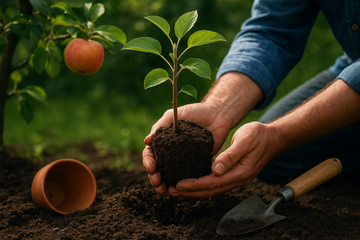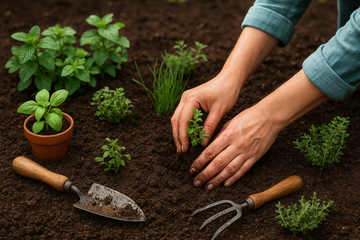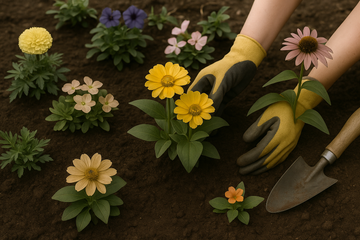Do you dream of a vibrant flower garden filled with color from spring through autumn? Starting your garden from seeds is one of the most rewarding and cost-effective ways to grow beautiful blooms. In this guide, we’ll walk you through everything you need: from choosing the right flower seed varieties, to sowing, caring, and harvesting.
If you want to shop while you read, check out our Annual Flowers collection it’s packed with gorgeous varieties you can seed in your garden.
1. Why Plant Flowers from Seed?
Starting flowers from seed has many advantages:
-
Greater variety: You can choose from hundreds of species and cultivars not always available as plants.
-
Cost savings: Seeds are typically far cheaper per plant than buying nursery plugs.
-
Control over timing: You can start earlier indoors or time your sowing to match your climate.
-
Satisfaction: There’s a special joy in watching a tiny seed become a flourishing flower.
However, it requires patience and a little technique. With good methods, you can get very high germination and strong seedlings.
2. Choose the Right Flower Seeds (Varieties & Types)
Before sowing, select appropriate seeds for your garden conditions.
Annuals vs Perennials vs Biennials
-
Annual flowers complete their life cycle in one season. Great for quick color.
-
Perennials flowers come back year after year with minimal replanting.
-
Biennials flowers take two years to bloom (first year vegetative, second year flowering).
Match to Conditions (sun, soil, climate)
Check each seed packet for:
-
Sunlight requirements (full sun, partial shade)
-
Soil moisture (well-draining, average, moist)
-
Hardiness / frost tolerance
Recommended Starter Seed Varieties
Here are a few popular and easy-to-manage flower seed options:
-
Helipterum Roseum Double‑flowered seeds – bright everlasting blooms
-
Zinnia California Giants seeds – classic summer color
-
Haning Petunia mixed seeds – perfect in containers
-
Carnation Picotee Fantasy mix – fringed blossoms, fragrant
-
Nasturtium Tom Thumb mixed seeds – edible, colorful trailing blooms
3. When & Where to Sow
Timing: Indoors vs Outdoors
-
Indoors first (seed starting): 6–8 weeks before last frost; essential for slow-germinating seeds or short growing seasons.
-
Direct sow outdoors: after last frost when the soil has warmed — ideal for hardy seeds.
Location & Containers
-
Use seed trays, small pots, or plug cells with clean, sterile seed-starting mix.
-
Place trays in a bright, warm spot (but not in direct harsh sun initially).
-
Maintain consistent moisture (mist rather than drench).
4. How to Plant Flower Seeds: Step-by-Step
Here’s a simple process:
-
Prepare seed tray / pot
Fill with moist seed-starting mix, tamp lightly. -
Sow seeds:
- Tiny seeds: sprinkle on surface and press gently (no covering or with very fine soil)
- Larger seeds: plant at depth = 2 × seed width
Always label rows with date and variety.
3. Cover & water gently
Use a fine mist or bottom watering to avoid displacing seeds.
4. Provide warmth & light
Use a tray cover to retain humidity till germination. Provide 12–16 hrs of light once sprouts appear.
5.Thinning / transplanting
When seedlings form true leaves, thin to one per cell or transplant into individual pots.
6. Hardening off
Gradually acclimate seedlings to outdoor conditions over 7–10 days.
7. Final planting outdoors
Plant in the garden, spacing according to seed packet instructions.
5. Care After Planting
Watering & Moisture
-
Keep soil consistently moist (not waterlogged).
-
Water early morning where possible.
Sunlight & Support
-
Most flowers prefer full sun (6+ hours daily).
-
Stake taller varieties or use supports to prevent bending.
Fertilization
-
Use mild liquid fertilizer when seedlings are established.
-
Compost top dressing helps with nutrients and soil structure.
Mulching & Weed Control
-
Apply thin mulch to retain moisture and reduce weeds.
-
Keep weeds away from young blooms.
Deadheading & Pruning
-
Remove spent blossoms to encourage continued flowering.
-
Pinch side shoots early to increase bushiness.
6. Seasonal Tips & Troubleshooting
-
Succession planting: Sow new seeds every few weeks to maintain color across the season.
-
Shade tolerant blooms: If part shade, choose tolerant species like impatiens or some perennials.
-
Pests & disease: Watch for fungal issues in humid weather — ensure good airflow.
-
Soil quality: Add organic matter or compost if soil is poor.
7. Sample Garden Plan (Example Layout)
| Row | Flower | Spacing | Notes |
|---|---|---|---|
| 1 | Zinnia California Giants | 20 cm | For vibrant borders |
| 2 | Helipterum Roseum | 15 cm | Dried flower potential |
| 3 | Petunia (low) | 20 cm | Container or edging |
| 4 | Nasturtium Tom Thumb | 20 cm | Edible trailing spots |
This mix will produce varied heights, colors, and types (annuals/perennials) for continuous interest.
8. Linking to SeedsChoice Products (Internal SEO)
To maximize SEO and keep visitors exploring your site, use internal links like:
-
Browse our full Annual Flowers collection
-
Try our premium cut flower seed mixes for fresh bouquets.
-
Check individual product pages such as Zinnia California Giants seeds , or Helipterum Roseum for detailed growing info.
9. FAQ — Frequently Asked Questions about Planting Flowers from Seed
Q: How deep should I plant flower seeds?
A: As a rule of thumb, plant a seed at about 2× its diameter. Tiny seeds often need just surface contact. Always check the seed packet for specific depth.
Q: How long until germination?
A: It depends on species — many annuals germinate in 5–14 days, perennials may take longer. Warmth and moisture speed up germination.
Q: When do I move seedlings outdoors?
A: Once frost danger has passed and seedlings have 2–3 sets of true leaves, and after “hardening off” to outdoor conditions.
Q: Can I sow seeds directly into the garden?
A: Yes — many hardy flowers do well when direct sown after frost. But delicate or slow-germinating species do better started indoors.
Q: How do I extend bloom time?
A: Use deadheading, succession planting, and balanced fertilization to encourage new blooms.
Q: Do I need to pre-soak seeds?
A: Some large or hard-coated seeds benefit from soaking 4–12 hours, but check your seed’s instructions. Over-soaking can cause rot.
10. Conclusion & Call to Action
Planting flowers from seed is a delightful journey—from that first sprout to a full bloom display. With careful selection, proper sowing, and regular care, anyone (beginner or experienced) can create a flourishing garden.
Explore our Annual Flowers collection to pick your next favorite varieties. Start small, experiment, and enjoy the rewards of watching life unfold from a tiny seed.
Happy gardening—and may your garden burst into color!












